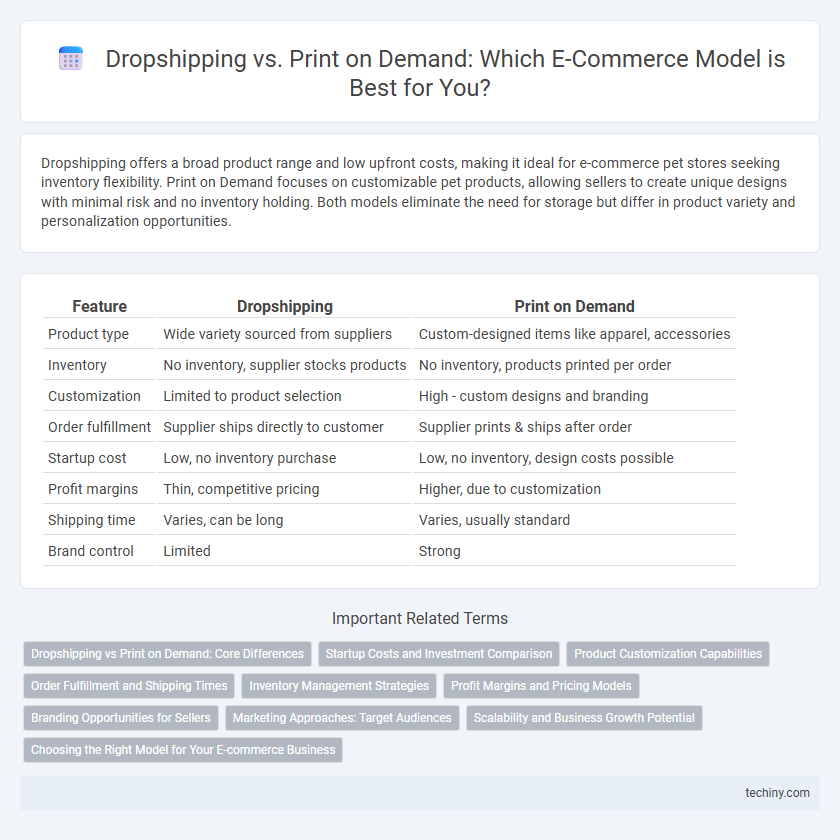Dropshipping offers a broad product range and low upfront costs, making it ideal for e-commerce pet stores seeking inventory flexibility. Print on Demand focuses on customizable pet products, allowing sellers to create unique designs with minimal risk and no inventory holding. Both models eliminate the need for storage but differ in product variety and personalization opportunities.
Table of Comparison
| Feature | Dropshipping | Print on Demand |
|---|---|---|
| Product type | Wide variety sourced from suppliers | Custom-designed items like apparel, accessories |
| Inventory | No inventory, supplier stocks products | No inventory, products printed per order |
| Customization | Limited to product selection | High - custom designs and branding |
| Order fulfillment | Supplier ships directly to customer | Supplier prints & ships after order |
| Startup cost | Low, no inventory purchase | Low, no inventory, design costs possible |
| Profit margins | Thin, competitive pricing | Higher, due to customization |
| Shipping time | Varies, can be long | Varies, usually standard |
| Brand control | Limited | Strong |
Dropshipping vs Print on Demand: Core Differences
Dropshipping involves selling products directly from suppliers without inventory, while Print on Demand specializes in customized products printed only after an order is placed. Dropshipping offers a wider product variety and faster scalability, whereas Print on Demand focuses on unique, personalized items with potentially higher profit margins. Inventory management and product customization distinguish the two models, affecting supplier relationships and fulfillment processes.
Startup Costs and Investment Comparison
Dropshipping requires minimal startup costs, primarily involving a domain, website hosting, and marketing, as inventory is managed by suppliers, eliminating the need for upfront product investment. Print on Demand involves higher initial expenditures due to designing custom products and sample orders, but no bulk inventory purchase is necessary, reducing financial risk. Both models offer low barriers to entry, yet dropshipping typically demands less capital compared to the design and product customization investments in print on demand.
Product Customization Capabilities
Dropshipping offers limited product customization since sellers rely on third-party suppliers who handle inventory and fulfillment without personalized options. Print on Demand specializes in customizable products, allowing businesses to add unique designs, logos, and personalized messages directly onto items. This capability enhances brand differentiation and meets growing consumer demand for bespoke merchandise in the e-commerce marketplace.
Order Fulfillment and Shipping Times
Dropshipping relies on third-party suppliers to handle order fulfillment, often resulting in variable shipping times depending on supplier location and inventory status. Print on demand integrates production and shipping, typically leading to longer fulfillment periods due to customization but offering precise tracking and fewer stock issues. E-commerce entrepreneurs should weigh the trade-offs between quicker shipping in dropshipping and tailored products with print on demand when optimizing customer experience.
Inventory Management Strategies
Dropshipping eliminates the need for inventory by directly shipping products from suppliers to customers, reducing storage costs and minimizing risk. Print on Demand requires no upfront inventory purchase by printing products only after a customer places an order, enabling highly customized items without stock issues. Both models optimize inventory management by leveraging supplier fulfillment, allowing e-commerce businesses to scale with minimal investment in warehousing.
Profit Margins and Pricing Models
Dropshipping typically offers lower profit margins ranging from 10% to 30% due to third-party supplier costs but allows competitive pricing flexibility with minimal upfront investment. Print on Demand often yields higher profit margins between 20% and 50% since products are customized and priced based on design value, enabling premium pricing strategies. Both models require strategic product selection and supplier negotiation to optimize profitability and maintain attractive price points in competitive e-commerce markets.
Branding Opportunities for Sellers
Dropshipping offers limited branding opportunities since products are typically sourced from third-party suppliers with minimal customization, restricting seller control over packaging and product presentation. Print on Demand enables sellers to create unique designs and brand-specific packaging, enhancing customer recognition and loyalty through personalized products. Focusing on Print on Demand allows e-commerce entrepreneurs to build stronger brand identity while maintaining low inventory costs.
Marketing Approaches: Target Audiences
Dropshipping targets a broad audience looking for diverse product selections and competitive pricing, relying heavily on digital ads and influencer marketing to capture impulse buyers. Print on Demand appeals to niche markets seeking personalized or unique items, utilizing social media platforms and content marketing to engage creative, trend-conscious consumers. Both models leverage SEO and email campaigns, but Print on Demand emphasizes storytelling to build community and brand loyalty.
Scalability and Business Growth Potential
Dropshipping offers high scalability by leveraging supplier inventory without upfront stock investment, allowing rapid expansion and wide product variety. Print on Demand scales through customization and niche targeting, but production speed and quality control may limit rapid growth compared to dropshipping. Both models support business growth, yet dropshipping's flexibility in sourcing and volume typically provides greater potential for scaling operations globally.
Choosing the Right Model for Your E-commerce Business
Dropshipping offers a wide product variety with low upfront costs, ideal for entrepreneurs seeking flexibility and minimal inventory risk. Print on demand specializes in customized products, providing unique branding opportunities through personalized designs without holding stock. Evaluating factors like product control, profit margins, and customer experience helps determine the optimal model for your e-commerce business growth.
Dropshipping vs Print on Demand Infographic

 techiny.com
techiny.com